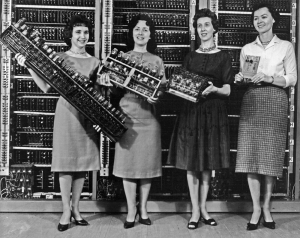
Code like a girl: how can we increase the number of women in STEM?


© Wikimedia Commons
In 1967, Cosmopolitan Magazine wrote that, unlike men, women were ideal computer scientists because “programming was just like planning a dinner.” So, what happened? In ‘Beards, Sandals, and Other Signs of Rugged Individualism: Culture & Identity,’ and ‘The Computer Boys Take Over,’ Professor Nathan Ensmenger paints a rich history of the masculinization of Computer Science. While programming in the 1950s and early 1960s was viewed as highly mechanical and repetitive – and therefore feminine – through the 1960s and 70s, the field grew masculine through a series of exclusive assessment-based hiring practices, exclusive professional certifications, and media messaging that re-wrote the stereotypes. Indeed, this combination of structural masculinization, limited early exposure to computer science, and limited media or personal role models have led computer science towards increasing masculinization. This runs contrary to other science disciplines like physics, bioengineering, and math. Unlike other STEM disciplines, computer science still sees declining numbers of female university graduates.
Based on this, my research focuses on technology and young women – particularly, the positive impacts that learning through new devices and learning to code may have on adolescent development. As Mitchel Resnick, creator of Scratch, a popular beginners coding language explained, “if you learn to code, you code to learn.” Indeed, by learning to code, children begin to consider themselves creators rather than consumers and through this gain a sense of agency and mastery that can be otherwise hard to find in adolescence. While these benefits are not unique to young women, given the dire picture painted above, it becomes critical to identify and measure solutions to give women the opportunities. In what follows, I review three things that the women in computer science community needs that have emerged from my research and professional practice.
Community:
My thesis research points to an unfortunate conundrum facing women in technical communities – a young woman’s sense of belonging and social fit is the most important factor for women to develop intrinsic motivation for study. Yet, if we don’t have women surrounding them, how can young females develop the sense of relatedness necessary to persist? While I haven’t fully answered this question, new participation models are making it easier for women to develop communities outside of school. I started an initiative called Code Like a Girl (now Bit by Bit), that creates a forum for young women in technology. Until I was 20 years old, I was always the only girl in my computer science classes. What if we brought all of these lone she-wolves together? Through Bit by Bit, young women from all across the New York area meet for a day of lectures, mentoring, and camaraderie that aim to foster the psychological sense of relatedness that appears necessary for persistence. I’m heartened that other geographies have adopted this model and are creating inter-school partnerships to manufacture the communities necessary for young women.
Break Down Media Role Models:
Our stereotypes of computer scientists emerged from 1970s hacker culture and episodes of The Big Bang Theory suggest that these images haven’t changed much over the past 40 years. Young women may struggle to identify with computer science or be uncomfortable showing an interest because of the powerful role that stereotypes and the media play in shaping what we can be. Indeed, studies out of the University of Washington show that when computer science classrooms are designed as ‘stereotypically male,’ women’s sense of belonging decreases as does their interest … even if the classroom is full of female students. These results point to the need to change media messaging and to elevate female role models. The outspoken voices of women like Sheryl Sandberg and Karlie Kloss take an important first step at breaking down these barriers. Additionally, through my work at Sesame Street, I traveled across the country to museums, libraries, and schools and watched as new educational models emerged that mixed programming with arts or with video game design. As such, they broke down stereotypes about who could belong and created new entry-points into computer science.
Measurement and Evaluation:
I recently tried to create a comprehensive database of all women in technology outreach efforts in the United States and, within minutes, saw the list explode with new efforts cropping up. Most of these initiatives involved some combination of community-building, mentoring, or education, but there was little uniformity of structure, content, or goal. More worryingly, none of the programs I reviewed had subjected themselves publically to rigorous measurement or evaluation of their impacts. At best, this means we don’t know the important impacts they are having. At worst, this means that millions of US grant dollars go towards ineffective or harmful practices. As we attempt to identify best practices for recruiting and retaining women in the [computing] sciences, it is critical that we evaluate, elevate, and scale what works. This is where places like OII and the broader university can and should have the biggest impact. By bringing rigorous research and the processes around evaluation to local community efforts, Universities can both prove efficacy where it exists, teach individuals how to measure their impact, and use their cache and peer-review to elevate and scale effective initiatives. I’m hopeful that given the outreach practices emerging on college campuses that they can also work with their parent universities to measure their impacts.
Most computer historians can’t name the six young women who programmed the first computer used by the US army. Despite being photographed with the machines they controlled, reporters mistook them as models showing off the machines and never credited their work. The so-called “ENIAC Girls,” programmed the computer without manuals and without a formal language. Yet, determined to keep others from this position, several of the women then worked writing the first computer manuals and developing new computer languages that would make it easier for what they assumed were the women to come. Still, for decades, historians ignored their contribution and that of the many women who followed. International Day of Women in Science celebrates the early contributions of the ENIAC Girls and the role they played in making the road easier for further generations. However, this day also celebrates the many young women working today to create the ENIACs of the future. Through my professional work at Sesame Street and my research efforts, I spend a lot of time with young women interested in technology. They are never content to just sit behind a screen. They are eager to go mentor younger women or to create new programs to get girls excited. I’m heartened that the young women I currently work with have the same spirit as the original 6. Their commitment to making the path a bit easier for the next girl helps create the next generation of role models, communities, and impact we need to succeed.